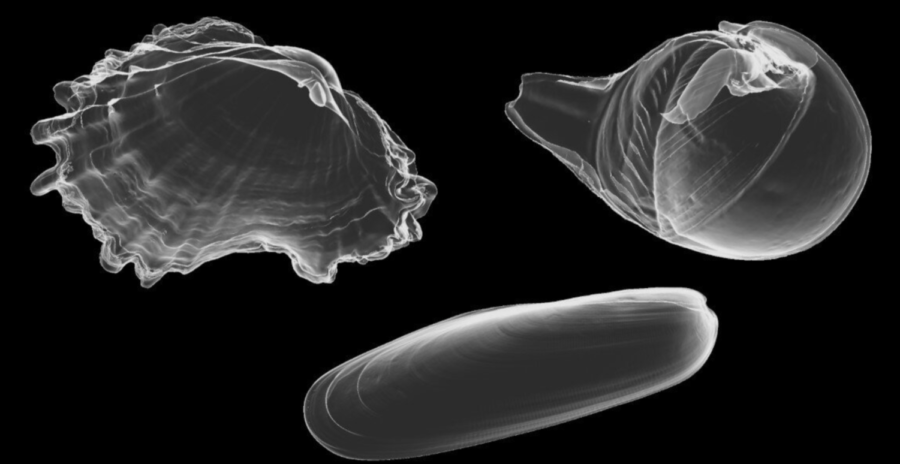UChicago Paleontologists Share Insights on New Rock-Boring Bivalve Study
The study is one of the first major studies done using three-dimensional images of bivalve morphology.
The researchers were surprised to see how rock boring bivalves are diverse in shapes and sizes.
May 8, 2023
A new paleontology study by UChicago researchers discovered that rock-boring clams, known as bivalves, vary in shape despite performing the same function. This paper is one of the first major studies done using three-dimensional images of bivalve shells. The Maroon sat down with scientists Katie S. Collins, Stewart M. Edie, and David Jablonski to talk more about their research and findings.
William R. Kenan, Jr., Distinguished Service Professor Jablonski currently runs the Jablonski lab in the Henry Hinds Laboratory for the Geophysical Sciences, where Collins and Edie both worked as a postdoc and Ph.D. student respectively. Collins is now working at the Natural History Museum in London as a molluscan paleontologist, while Edie is a paleobiologist and fossil curator at the Smithsonian.
Jablonski credits the success of the paper to his partnership with Collins and Edie. “It has been a blast working with them,” Jablonski said. “They’re wonderful, wonderful colleagues—ridiculously smart […] It’s been this really fruitful, mutually reinforcing, and complementary kind of collaboration that has been really rewarding to have it persist beyond the time they were actually here in Chicago. Our team also includes some great undergraduates.”
Jablonski and his team decided to narrow their focus to bivalves as the completeness of their fossil record and richness of their morphology make them ideal to explore the big and ambitious questions about biodiversity and the rules of evolution. The paper stemmed out of Collins’s fascination with how rock boring appears to be a difficult way of living for a clam, since they are typically boring into incredibly solid rock that is harder than their own shells, and how that relates to the wide range in shell shapes.
“[Bivalves] are common, they have a long fossil record, their morphology is super informative, they’re understudied because they’re kind of difficult, and they give you all this data about the evolution of ecosystems through time. They are just absolutely full of info, and I’ve never gotten tired of that,” Collins said.
The study was specimen-driven with the aim to include every rock-boring bivalve species. Collins, Edie, and Jablonski spent about a year collecting data from various museums and bringing it back to UChicago, where they micro-CT scanned each shell in order to make a three-dimensional model of its morphology. They scanned over 4,500 shells over the course of the study and compared their shape to test certain patterns of evolutions. However, the diversity of bivalve shells posed a challenge, and researchers tried many approaches before landing on a successful mathematical method.
Researchers realized that because these bivalves are boring into rock rather than other materials, they don’t have to be a specific shape. “It’s a lot harder to burrow into waterlogged sediment than it is to bore into rock. If you’re a bivalve trying to get into waterlogged sediment, the water is incompressible, it will not get out of your way, and it is actively trying to push you back. Whereas when you’re boring into rock, the rock gets out of your way […] If you’re a rock-boring bivalve, you can use that to your advantage because you can grind at the rock, and then the water you’re pulling in can take all of that rock debris away,” Collins said.
Despite the researchers finding that rock-boring is easier than expected, rock-boring bivalves have never diversified. There is only one family of bivalves comprised solely of rock-borers, called Pholadidae, but it only has 76 member species. This is small for a bivalve family, as many other bivalve families have hundreds of member species, and only one or two of them are rock borers.
The researchers have described this as an evolutionary dead-end. This is unusual because advantageous traits like rock boring typically spread throughout a family and result in new species. Another possible explanation is the limited availability of hard material on the ocean floor for bivalves to bore into. “Although there are certain things in common among some of the lineages, it turns out that where they start from in terms of the different evolutionary lineages actually determines to some extent how they actually manage to pull it off,” Jablonski said. “There’s nothing better for a scientist than doing an analysis and getting a result that’s counter to your intuition. Because that means you have to realign a lot of your thinking in an interesting way.”
Their findings contribute to the discussion of the predictability of evolution, and next steps for them include applying this method over all modes of life and investigating how different measures of biodiversity respond to various environmental pressures.
Edie described a milestone moment during the study when they were able to quantify the morphologies.
“It was very special,” Edie said. “I still remember the day that Katie and I were working in the lab at our computers side by side. We had finally cracked the method for digitizing the morphology […] And we just sat back and went, wow, it worked. Actually, if you go into the lab today, which is this tiny room in Hinds, we still have a printout of that initial space up on the wall. All of our plots that we’re very proud of, are still arrayed on the wall. We have to celebrate these little victories, because there’s plenty of stuff that goes wrong every day. So when something goes right, we get pretty excited.”













